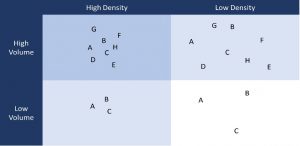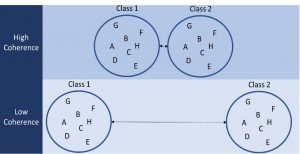Dear blog reader,
This week we are joined by both Jordan Belisle and Alison Stapleton, two individuals at the forefront of research in contextual behavioral science. As you will see, their contribution makes an explicit effort to emphasize the cooperation and collaboration we are trying to emulate in this blog series. Specifically, they provide us with a nuanced view of Jordan’s work with the concept of relational density and how it may interact with current views of rule-governed behavior (RGB), an area we have always found extremely fascinating (well, we may be a little biased, Colin did focus his entire PhD on RGB, but still!). Anyway, sit back, folks, and enjoy!
Colin and Dermot
About the authors:
 Jordan Belisle, PhD, is an Associate Professor at Missouri State University in the Behavior Analysis and Therapy program. Jordan’s research focuses on extending and applying relational frame theory. He has published over 80 peer reviewed articles and book chapters in his early career. He is also author of two books: Research Methods for the Practicing Behavior Analyst and Acceptance and Commitment Therapy for Behavior Analysts. He co-developed relational density theory as an extended framework of complex language and cognition. Jordan was also part of the development team for the PEAK relational training system and continues to research this technology today. At ABAI’s annual conference this year, Jordan and his lab (HUB Research and Practice Lab) presented in over 30 events, including symposium and poster presentations of graduate and undergraduate student research.
Jordan Belisle, PhD, is an Associate Professor at Missouri State University in the Behavior Analysis and Therapy program. Jordan’s research focuses on extending and applying relational frame theory. He has published over 80 peer reviewed articles and book chapters in his early career. He is also author of two books: Research Methods for the Practicing Behavior Analyst and Acceptance and Commitment Therapy for Behavior Analysts. He co-developed relational density theory as an extended framework of complex language and cognition. Jordan was also part of the development team for the PEAK relational training system and continues to research this technology today. At ABAI’s annual conference this year, Jordan and his lab (HUB Research and Practice Lab) presented in over 30 events, including symposium and poster presentations of graduate and undergraduate student research.
 Alison Stapleton is a PhD Candidate at University College Dublin, Ireland. Alison’s dissertation focuses on selfing and rule-governed behavior in accordance with relational frame theory. Alison has published ten peer-reviewed articles and co-authored two book chapters on these topics. Alison is a member of the Journal of Contextual Behavioral Science Student Editorial Board, co-founder of the ACBS Superlab, and currently works at ACT Now, a leading provider of acceptance and commitment therapy training in Ireland.
Alison Stapleton is a PhD Candidate at University College Dublin, Ireland. Alison’s dissertation focuses on selfing and rule-governed behavior in accordance with relational frame theory. Alison has published ten peer-reviewed articles and co-authored two book chapters on these topics. Alison is a member of the Journal of Contextual Behavioral Science Student Editorial Board, co-founder of the ACBS Superlab, and currently works at ACT Now, a leading provider of acceptance and commitment therapy training in Ireland.
The Road Less Simple: Relational Density Theory and Rule-Governed Behavior
Are our current methods and principles in applied behavior analysis adequate to address the complexities of human experience? Can we explain why a father chooses to gamble despite defaulting on his mortgage and putting his child’s educational savings on the table for the chance to win big? Do we understand the psychological experience of the same man’s daughter navigating high school for the first time, yearning for friendship, and struggling to find her way? There are so many challenges that a well-designed contingency management system – no matter how elaborate – simply cannot solve. And, as long as we define ourselves by this singular, albeit elegant approach, we may only offer superficial solutions to these challenges – the very challenges that come with being human.

We are at a crossroads as a field. A first road to broaden our scientific repertoire to account for the vast complexity of the human experience. This road is not yet paved and has only been traveled by a few, some of whom have returned to tell us what potentially lies ahead (Association for Behavior Analysis International, 2018, Acceptance and Commitment Therapy Seminar). The road less traveled. A second road to narrow our scientific repertoire; deferring to other disciplines when complexity shows up and abandoning Skinner’s vision of an all-encompassing (i.e., radical) approach to a science of human behavior. This is a road well-traveled and accesses the same reinforcers we have grown accustomed to – successful working (in some ways) with a singular population to resolve only a handful of challenges.
Now more than ever we have what is needed to progress down this first road, though it will undoubtedly require great mutual effort from scientists and practitioners alike. This piece describes two evolving areas of research that we believe could contribute considerably to this effort along with other contemporary advances within our own science – rule-governed behavior (RGB) and relational density theory (RDT). Both approaches originate from Skinner’s work and extended accounts of relational frame theory (RFT; S. Hayes et al., 2001). An elaborate piece explaining RFT and modern advances was developed for this very series that can orient readers to this essential framework (Up-dating RFT: Cooperation Came First, the ROE as a Unit of Analysis, and Engineering Prosocial Behavior – Behavior Science Dissemination (abainternational.org).
The Relational Frame Theory Account of Rule-Governed Behavior
RGB is at the heart of “understanding.” Skinner defined RGB as behavior controlled by “rules derived from the contingencies in the form of injunctions or descriptions which specify occasions, responses, and consequences” (Skinner, 1969 p.160). Skinner famously did not detail how words and symbols came to refer to events in nature and was not specific about ‘specifying’ even means nor the active role of the listener (O’Hora & Barnes-Holmes, 2004). Transformation of stimulus function addresses what it means to specify – that words in a rule are functional (i.e., occasion or evoke behavior) through entailment with other words and stimulus events – and these relations can be immensely complex. As such, transformation of stimulus function is the foundation of an RFT approach to RGB. From an RFT perspective, rules are verbal antecedents consisting of transformations of function according to multiple stimulus relations (Barnes-Holmes et al., 2001; Törneke et al., 2008).
Due to its inclusion of a functional analysis of listener behavior, when talking about RGB in accordance with RFT, we often talk about theoretically distinct types of contingencies that produce rule-following/non-following (S. Hayes et al., 1998). Basically, people follow rules for different reasons. People may follow rules because the behavior of rule-following itself has been previously reinforced (pliance), or people may follow rules because the behavior specified in the rule allows them to experience desirable natural consequences (tracking).
Moreover, from an RFT perspective, when approaching rule-following, we are less interested in the rule as it was stated (the topography) and more interested in how the rule is understood by or functions for the listener (the function). To illustrate this, consider the following example: a parent tells a child “if you clean your room, you can play with your friends.” Here, the speaker explicitly states a contingency. However, the child’s room cleaning behavior may not be controlled by this contingency depending on how they have understood the rule and which parts of the network are cued to guide behavior. The child may instead clean their room because of a history of reinforcement for complying with their parent’s requests or any number of other co-occurring contingencies in the context.
Through the processes of derived relating and striving for a coherent knowing, a single stated rule can give rise to a number of other rules, resulting in increasingly complex networks of relations to guide behavior. Returning to the previous example, the child could further derive that clean (A) is the opposite of messy (B), and that being clean causes others to want to be around you (A-C) while being messy causes others to not want to be around you (B-D). Because rules can control behavior long after they have been derived, in the future, if the child has a friend visiting for a sleepover, the A-C/B-D rules may come online and the child may clean their room in preparation, with or without their parents guidance and independent of their expectations. In this way, stimulus control of the social event is altered by understanding what all the event entails (pun intended).
Relational Density Theory: Expanding the Account
So far, our examples illustrating the interplay between rule-governed behavior and relational learning have been simple and have not extended beyond three or four relational class members (e.g., A, B, C, and D). This mirrors research on relational framing that has occurred in basic experimental demonstrations and in translational research (Dixon et al., 2018). Yet, it is unlikely that relational learning actually is that simple. Everything can be related to everything along some dimension. How is a banana different from a squirrel? [Think of your own answer]. Maybe you peel one and (hopefully) not the other? And how are they the same? Both are long and narrow – at least when compared to a bowling ball. If everything can be related to everything else along myriad dimensions, then we need a method for quantifying the interactions between multiple (and potentially infinite) to play with them scientifically and doing more than invoking narrative metaphors of waves and streams.
The ability to relate stimuli in many ways and across multiple dimensions can pose a number of challenges. In experimental contexts, during relational tasks, researchers often describe stimuli classes as unrelated if the classes appear (or are assumed) to be distinct. To illustrate this, imagine we have taught participants A = B = C and D = E = F. If my relational task required participants to select the comparison stimulus that was most similar to a sample stimulus (e.g., select A, not D or E, when presented with B), and our analysis focused solely on response ‘accuracy’ (i.e., presence/absence of A-B), we fail to capture nuances in participants’ responding (e.g., participants could also equate A and D as both are stimuli in the same experiment, etc.; what constitutes a single class is unclear).
Of course, relating occurs in a context — how we respond relationally depends on contextual cues in the environment. In the previous example, it makes sense for participants to relate A = B = C as distinct from D = E = F since that aligns with what we taught there and then. However, distinction is a relation in and of itself that would not be captured in my procedure, not to mention other relation types we are not capturing. If we approach this solely in terms of non-contextual presence/absence of a particular relation type within classes (as opposed to overall degree of relatedness within and between networks as per RDT), we are missing the complete picture; we have lost a great deal of scope and depth while risking a false sense of precision. Returning to the topic of RGB, although we can (on some level) model simple rules in the lab, RGB operating in the real world is fundamentally more complex.
RDT offers a way to describe not only the degree of relatedness between stimulus events, but also the relations that exist between apparent distinct classes (i.e., distinction is a relative term as nothing is truly distinct). RDT provides an extension of RFT that suggests relations differ in their degree of relatedness and this appears to predict higher-order patterns of relational responding. When classes contain closely related stimulus events, the class can be described as operating at high density.  And, when the same class contains several related stimulus events, the class can be described as operating at high volume (see figure on the right). Borrowing from Newton’s classical mechanics, we might predict that classes that are dense and voluminous are also highly resistant to change (relational mass = density * volume). This was demonstrated in initial empirical investigations of the theory and more evaluations are currently underway (Belisle & Dixon, 2021).
And, when the same class contains several related stimulus events, the class can be described as operating at high volume (see figure on the right). Borrowing from Newton’s classical mechanics, we might predict that classes that are dense and voluminous are also highly resistant to change (relational mass = density * volume). This was demonstrated in initial empirical investigations of the theory and more evaluations are currently underway (Belisle & Dixon, 2021).
Relational classes may also participate within complex networks that contain multiple classes and are defined by their relative relatedness, or coherence (a class is a distinct cluster of relations, not something that is truly “distinct” from other classes and only relatively so). This is shown in the figure below, where the classes on the top are closer to one another than are the classes on the bottom. We might predict that, relative to the bottom classes, the top classes are more likely to merge under the same environmental constraints because they are more coherent. We have demonstrated this phenomenon in basic experimental arrangements (Belisle & Clayton, 2021) and in translational research on issues related to sexist and racist beliefs (Belisle, 2022).

Even these classes may participate coherently and non-coherently with many other classes, allowing for potentially infinite levels of analysis, scaling from molar and molecular accounts of relational behavior. We have achieved this analysis using a geometric representation called a “geospace” developed from a statistical analysis called the multidimensional scaling procedure (Clayton & L. Hayes, 2004) to look at relational behavior in this way that has opened up even more opportunities for basic and translational investigation.
How Can Rule-Governed Behavior and Relational Density Theory Improve Analyses?
We recognize that relational patterns do not cause external behaviors per se; external behavior is part of the behavioral stream that includes relational responding. Behavior cannot cause itself. Influence is found in the context and contingencies that maintain following this or that rule, or even responding in terms of coherent and densely established networks in the first place.
We may be more likely to follow rules that align with other rules that have already been established and reinforced (Stapleton, 2020). To illustrate with another social example, imagine you are told to avoid Person A and that Person A engages in behaviors that are similar to others who you tend to avoid (e.g., they act selfishly, listen to bad music; all contained within vast networks with negative affective functions). Following this rule (i.e., avoiding Person A) may be highly probable in this context, even if you have never interacted with Person A before. The greater the volume (more and more coherent rules supporting avoidance) and density (clear correspondence between the behavior and the person supported by multiple exemplars of observation and reports from others), the more likely the rule is to evoke avoidance and the more resistant this pattern may be to change when given counter information (i.e., they like one good song). In contrast, if Person A was related to a number of stimuli that carry an approach function (e.g., they appear to care about others; listen to good music, etc.), these dominating positive functions may undermine the stated rule of avoiding Person A. The advice to avoid this person is ignored and, hopefully, a new friend is made.
In this way, it may be the case that rules build upon existing and coherent networks of rules that can be highly resistant to change. This general idea could provide a model for exploring outcomes like political echo chambers, conspiracy theories, self-limiting self-rules, (un)willingness to engage in behavioral activation, etc. since these networks are supported not only by restricted beliefs but by entire ecosystems of relations and unworkable rules about how the world operates, how the self should behave, and so on.
Why Does Any of This Matter Outside the Lab?
There are myriad implications of this RFT-RDT-RGB synergy in terms of clinical interventions and even answering some deeper philosophical questions.
First, rules that are disruptive to clients’ lives may differ in their resistance to change. When rules are highly resistant, attempts to restructure rules (i.e., cognitive restructuring) may be less effective than acceptance and commitment based approaches that attempt to alter the stimulus function of rules toward valued-living. Can we weaken the stimulus control exerted by networks of unworkable rules on our ability to live a life of vitality and value? With the geospace, RDT provides a new way to look at self rules – that is we can literally see how ‘sticky’ or tightly held (coherence; resistant to change) a rule is and track this across time, pre-/post-interventions, etc.
Second, when introducing new rules to clients, transformations of function (i.e., changes in behavior) may be more likely to occur when those rules align with rules that clients already hold/ ‘show up’ with. In the context of working with clients with focused interests, we might assume that those interests contain elaborate and complex relational networks that could expedite the learning of new concepts and serve as a framework to guide intervention. We have done some early case study work using characters and plot points from Star Wars to guide intervention in this way.
Ultimately, we want to empower people to move from rigid rule-following to flexible rule-following that is sensitive to shifting environmental contingencies. We want to disrupt unhelpful patterns of relating and undermine problematic rules, while attending to the client in the room (their perspectives and function, their values, behaviors they wish to change andtheir motivation underlying the desire to change that specific behavior), while being humbled that we are only ever accessing a small fraction of their complex relational networks and experiences. In part, this may be achieved by weakening problematic relations that inhibit accurate tracking within dense classes and by building voluminous or expansive networks around the client’s values. By building relational networks around valued living, we might expect to see a broadening of behavioral repertoires that operate in the service of those values.

There are potential implications for answering deeper questions as well, like exploring “self,” the nature of being and of becoming. It is yet possible that the center node of this vast universe of relational complexity is the aggregate of your relational context operating within nested layers of more elaborate relational context – and this aggregate product is you. A constant, bound together within surging threads of chaotic interaction. Of course, all of this requires basic research, and we are only scratching the surface on how to evaluate RDT and RGB at this level of analysis. Time will tell if this kind of analysis is possible given these two theoretical approaches and integrated within the many others emerging in our science.
Taking the Road Less Traveled
We are at a crossroads as a field; the choice to broaden our repertoires to (potentially) better account for complexity or not. Many of the ideas we mentioned here are still in their infancy, though they likely represent a broadening of scientific repertoires; we hope sharing these ideas as we have will inspire others to work toward answers to these complex questions that affect our clients and our understanding of our world.
As a field, we must constantly consider and reconsider the rules we are using to guide our practice; flexibly selecting optimal behaviors as best we can, guided by what works, and maybe even taking the road less traveled.
References
Association for Behavior Analysis International. (2018). Acceptance and commitment therapy seminar. Retrieved from https://www.abainternational.org/events/program-details/event-detail.aspx?intConvId=55&by=Day&date=5/29/2018
Barnes-Holmes, D., O’Hora, D., Roche, B., Hayes, S. C., Bisset, R. T., & Lyddy, F. (2001). Understanding and verbal regulation. In S. C. Hayes, D. Barnes-Holmes, & B. Roche (Eds.), Relational frame theory: A post-Skinnerian account of human language and cognition (pp. 103–119). Plenum.
Belisle, J. (2022). Relational Density Theory and Cultural Selection. Symposium presented at the Annual Association for Behavior Analysis International conference. Boston, MA
Belisle, J., & Clayton, M. (2021). Coherence and the merging of relational classes in self-organizing networks: Extending Relational Density Theory. Journal of Contextual Behavioral Science, 20(1), 118-128. https://doi.org/10.1016/j.jcbs.2021.03.008
Belisle, J., & Dixon, M. R. (2020). An exploratory analysis of relational density theory: Relational resistance and gravity. Journal of Contextual Behavioral Science, 16(1), 80-95. https://doi.org/10.1016/j.jcbs.2020.01.013
Bordieri, M. J., Kellum, K. K., Wilson, K. G., & Whiteman, K. C. (2016). Basic properties of coherence: Testing a core assumption of relational frame theory. The Psychological Record, 66(1), 83-98. https://doi.org/10.1007/s40732-015-0154-z
Clayton, M. C., & Hayes, L. J. (2004). A comparison of match-to-sample and respondent-type training of equivalence classes. The Psychological Record, 54(4), 579-602. https://doi.org/10.1007/BF03395493
Dixon, M. R., Belisle, J., Rehfeldt, R. A., & Root, W. B. (2018). Why we are still not acting to save the world: The upward challenge of a post-Skinnerian behavior science. Perspectives on Behavior Science, 41(1), 241-267. https://doi.org/10.1007/s40614-018-0162-9
Dougher, M. J., Hamilton, D. A., Fink, B. C., & Harrington, J. (2007). Transformation of the discriminative and eliciting functions of generalized relational stimuli. Journal of the Experimental Analysis of Behavior, 88(2), 179-197. https://doi.org/10.1901/jeab.2007.45-05
Hayes, S. C., Barnes-Holmes, D., & Roche, B. (2001). Relational frame theory: A post-Skinnerian account of human language and cognition. Plenum.
Hayes, S. C., Gifford, E. V., & Hayes, G. J. (1998). Moral behavior and the development of verbal regulation. The Behavior Analyst, 21(2), 253–279. https://doi.org/10.1007/bf03391967
O’Hora, D. & Barnes-Holmes, D. (2004). Instructional control: Developing a relational frame analysis. International Journal of Psychology and Psychological Therapy, 4(2), 263-284.
Roche, B., Barnes-Holmes, Y., Barnes-Holmes, D., Stewart, I., & O’Hora, D. (2002). Relational frame theory: A new paradigm for the analysis of social behavior. The Behavior Analyst, 25(1), 75-91. https://doi.org/10.1007/BF03392046
Skinner, B.F. (1969). Contingencies of reinforcement: A theoretical analysis. Appleton-Century-Crofts.
Stapleton, A. (2020). Choosing not to follow rules that will reduce the spread of COVID-19. Journal of Contextual Behavioral Science, 17(1), 73-78. https://doi.org/10.1016%2Fj.jcbs.2020.07.002
Torneke, N., Luciano, C., & Valdivia-Salas, S. (2008). Rule-governed behavior and psychological problems. International Journal of Psychology and Psychological Therapy, 8(2), 141–156.
